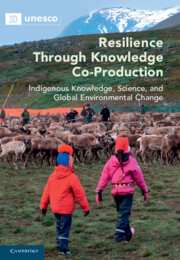 Resilience through Knowledge Co-Production
Resilience through Knowledge Co-Production Book contents
- Resilience through Knowledge Co-production
- Resilience through Knowledge Co-production
- Copyright page
- Contents
- Contributors
- Acknowledgements
- Introduction
- Part I From Practice to Principles
- 2 The Progression from Collaboration to Co-production: Case Studies from Alaska
- 3 Learning about Sea Ice from the Kifikmiut: A Decade of Ice Seasons at Wales, Alaska, 2006-2016
- 4 Shaping the Long View: Iñupiat Experts and Scientists Share Ocean Knowledge on Alaska’s North Slope
- 5 Indigenous Ice Dictionaries: Sharing Knowledge for a Changing World
- 6 Mapping Land Use with Sámi Reindeer Herders: Co-production in an Era of Climate Change
- 7 Sámi Herders’ Knowledge and Forestry: Ecological Restoration of Reindeer Lichen Pastures in Northern Sweden
- Part II Indigenous Perspectives on Environmental Change
- Part III Global Change and Indigenous Responses
- Epilogue
- Index
- References
6 - Mapping Land Use with Sámi Reindeer Herders: Co-production in an Era of Climate Change
from Part I - From Practice to Principles
Published online by Cambridge University Press: 02 June 2022
- Resilience through Knowledge Co-production
- Resilience through Knowledge Co-production
- Copyright page
- Contents
- Contributors
- Acknowledgements
- Introduction
- Part I From Practice to Principles
- 2 The Progression from Collaboration to Co-production: Case Studies from Alaska
- 3 Learning about Sea Ice from the Kifikmiut: A Decade of Ice Seasons at Wales, Alaska, 2006-2016
- 4 Shaping the Long View: Iñupiat Experts and Scientists Share Ocean Knowledge on Alaska’s North Slope
- 5 Indigenous Ice Dictionaries: Sharing Knowledge for a Changing World
- 6 Mapping Land Use with Sámi Reindeer Herders: Co-production in an Era of Climate Change
- 7 Sámi Herders’ Knowledge and Forestry: Ecological Restoration of Reindeer Lichen Pastures in Northern Sweden
- Part II Indigenous Perspectives on Environmental Change
- Part III Global Change and Indigenous Responses
- Epilogue
- Index
- References
Summary
This chapter presents a co-produced research that took place since 2009 between interdisciplinary scientists and herders from a Sami reindeer community in northern Sweden. This research was conceived in response to a participatory mapping program, the Reindeer Husbandry Plan (RHP), led by the Swedish Forest Agency. The RHP is based on a digital tool compiling and mapping habitat use by reindeer herding communities. Mapping land use, even with participatory methods, is a powerful tool which could lead to the best or the worst, despite initial good intentions. Knowing how zoning and mapping the best available pastures was a complex issue in a changing subarctic environment, we wondered how the RHP would succeed in such a difficult enterprise. How could Sami herders map 'good pastures' which can suddenly become bad, while less good pastures, can, according to circumstances, become the best choice? The purpose of the co-produced project was to include the complexity of Sami herders’ knowledge and worldviews, their land management and their science of the snow, into the RHP, while developing an original methodology to map the use of winter grazing lands by Sami reindeer herders in northern Sweden.
Keywords
- Type
- Chapter
- Information
- Resilience through Knowledge Co-ProductionIndigenous Knowledge, Science, and Global Environmental Change, pp. 117 - 142Publisher: Cambridge University PressPrint publication year: 2022
